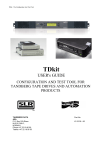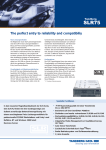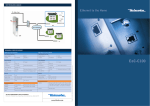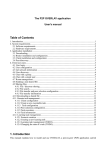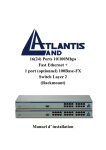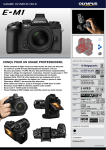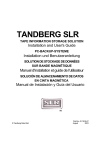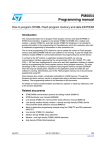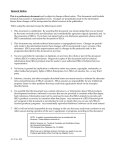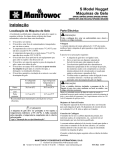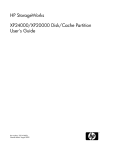Download Tandberg Data Streamer SLR140 Internal Grey
Transcript
SLR140 Features SLR140 Technology and Features Author: Willy A. Johansen, Corporate SLR Product Manager Date: October 1, 2003 SLR140 – The newest tape drive in the reliable and scalable SLR family 1. Why Backup Lost Data Cost U.S. Economy $11.8 Billion in 1998; Pepperdine Professor Estimates Average Incident of Lost, Stolen or Damaged Data Runs More Than $2,500 per Affected PC. (With reference to "The Cost of Lost Data" report from Stac Software Inc.). This is considered even more true today. The report projects costs are likely to increase as the need for distributed computing increases. Extra costs are likely to be incurred if more than one PC on a network is affected and without protection such as virus software and backup systems, large-scale problems over the network could cripple an organization. Smith also states that the costs may even be much higher, as some factors are difficult or impossible to quantify, such as potential sales losses, lost opportunity, damage to company reputation and complete loss of the knowledge itself. According to the report, hardware failure, human error, software corruption and viruses are the leading causes of data loss. Theft, which is prevalent among laptops, was responsible for five percent of lost information while the remaining three percent of incidents was the result of complete hardware destruction from events such as floods, brownouts and lightning. "There are two possible outcomes for lost data," said researcher Smith. "Either it is recoverable with the help of technical personnel, or it is completely lost and needs to be re-entered. Both scenarios involve significant hours of work and considerable sums of money." 2. The Most Important Factors for a Backup Solution! The three most important factors for a backup device are: a) Trouble-free restore • When everything else fails a restore from the backup media MUST be guarantied! Restore of data is normally not an every-day-operation, but for most companies restore of lost data will be needed at some time. A trouble-free restore can only be guarantied by having reliable hardware solution, removable media, reliable software, and a good, easy to understand backup routine. b) Performance and backup speed • The time window available for backup depends on how long the host can be occupied with backup. The actual time for a backup operation depends on the total system performance including the access time of the hard disk, number of files, size of the files, transfer rate of the network, performance of the operating system and backup application software, and the performance of the tape drive for the different types of data. D:\SLR140 Features for Reliability and Performance.doc Page 1 of 13 Printed: 30.03.04 15:17 SLR140 Features • Having enough capacity on the backup device to store all backup data is of course also important for keeping the backup time within the time window. • Normally a tape drive has embedded a hardware compression. There are several algorithms in use – one more effective on certain types of data, than the other. • Data to be backed up will for most companies, be a mix of data that can be compressed from no compression at all (1:1) to several times of compression (x:1). The tape drive should also be able to have a linear increase of the transfer rate as the compression ratio increases. Compression ratios of e.g. 3:1 – which is quite normal within a business - should accommodate a three times higher transfer rate than the specified native transfer rate. c) Compatibility and Scalability • If everything else fails – which can happen during a flood, fire or willful damage - it is outmost important that the backup tape media can be guarantied to work in another similar tape drive. • As trouble free restore is very important for a backup system, being able to stay with a known, reliable technology over years becomes more important. Reliability means that the user can feel assured that a restore operation can be performed without any problems. This requires that the tape technology chosen can offer a growth path in capacity, transfer rate, and automation products that cover the growing need for the customers needs for data protection. • For many customers it is also important to be able to read older media, and also for some customers to be able to write to data on older media formats for data transfer and software distribution. 3. Importance of Trouble-free Backup Performing backup every day, storing the original or a copy of the backup media in a place where the risk is minimal for it to get lost, destroyed or stolen, is a good start. Using a highly reliable tape drive technology and well planned routines for backup will minimize the work and hassle when the need for restoring of data occurs. A well planned backup routine can be one of several e.g.: Routine Description Advantage Full backup every day The whole disk is backed up One or one set of backup media contains all data at the time of full backup. Maximum of data loss will be one day of data input. This is the easiest way to restore data Incremental Full backup once a week, and every day backup of only new data One or one set of backup media contains all data at the time of full backup. One or a smaller number of media per day contains the new data for each day. The daily incremental backup takes shorter time but restore of data can mean searching for the media with the requested data. Differential Full backup once a week, and every day backup of new data since the full backup One or one set of backup media contains all data at the time of full backup. One or a smaller set of media per day contains the new data since the last full backup. The daily differential backup takes shorter time than the full backup. Restore of data means using the full backup media and the latest differential backup media. D:\SLR140 Features for Reliability and Performance.doc Page 2 of 13 Printed: 30.03.04 15:17 SLR140 Features Visit www.tandberg.com White papers or www.imation.com/smallbusiness for backup planning and implementation guidance. Like for insurance it is when an incident occurs you can see if the insurance was worth paying for. Being able to recover from the incident or being able to restore the data after data loss is the whole and single reason for the insurance and for the backup. For a backup device it is essential that data can be restored at any time – on the original device or on a similar device. A mechanical device like a hard disk drive or a tape drive will break at one time. Disk drives are much more in use than a tape drive, and disk drives are thus more likely to break if everything else is similar in regards to mechanical parts. Even a RAID 5 system is not fully fault tolerant. The more mechanical parts and the more moving mechanical parts, the more likely it is that a failure will occur earlier. Especially this is true if the mechanical parts have a direct with the media. There are several techniques on how to write data to, and read data from a magnetic tape media. The linear technique is the one using less mechanical and moving mechanical parts that can influence reading and writing, and thus linear is regarded as the most reliable technique. The linear technique is used on most higher capacity tape drives for backup like DLT, LTO, Magstar and SLR. Change track = move head Change tape direction Direction of recording Linear technique means writing data on a longitude track in the whole length of the tape media. Only at the end of the media the write/read head is moved to another position and to a new track. The Tandberg SLR (Scalable Linear Recording) product is the tape drive – within linear technology that has the fewest moving mechanical parts – the head, and the capstan motor in addition to the cartridge load/eject mechanism which all technologies have. The read/write head is moved to another position/track at the end or beginning of the tape media whilst the capstan motor drives the tape media in forward and reverse directions. For the SLR technology, the media is always inside the cartridge, and all media wear components are inside that cartridge. This again means higher quality as most of the wear parts of the backup system are replaced when the media is changed. 4. Importance of High Performance Time available for backup For more and more companies, the time window for backup is shrinking while the amount of data is increasing. For some server platforms, the time window for backup is down to one hour or even less. To cope with such requirements one needs not only a fast tape drive, but also a tape drive that can adopt to the speed of the data coming to the tape drive. Also the data path from the hard disk to be backed up to the tape drive is essential. A 100Mbit-network connection line only can support about 4 to 5 Mbytes/sec of data transfer in total for all devices connected. This means only 14 to 18 gigabytes per hour shared between all devices communicating on this network. Thus a direct connection of the backup tape drive to the host/server where the hard disk is installed is the best solution. For such a direct connection using a Ultra 2 SCSI interface, the possible burst transfer rate of the bus is 80 Mbytes/sec – or 288 gigabytes per hour. Then the speed of the backup is limited to the maximum speed of the tape drive, and how well the tape drive can buffer, compress, and process different types of data. D:\SLR140 Features for Reliability and Performance.doc Page 3 of 13 Printed: 30.03.04 15:17 SLR140 Features The newer SCSI interfaces – Ultra160 and Ultra320 supports the older Ultra2 interface. This means that an Ultra 2 device can run at its maximum speed without slowing down any Ultra160 or Ultra320 device. Hard disk MLR 100 megabit line Hard Max. speed: 4 - 5 megabyte/sec disk MLR Wide Ultra2 Max. speed: 80 megabyte/sec Tape drive Data transmitted from remote server – speed limited to the speed of the line vs. directly attached to the server – speed limited to maximum sustained transfer rate of the tape drive. Data compression Some types of data can not be compressed e.g. pictures and Zip files, and others can be compressed more than ten times e.g. text, numbers. In an office environment there is a mix of these types of data. Dependant on type of company, and what kind of data the company normally uses, an average compression ratio can be much more than 2:1 as the tape drive industry normally is using as a guideline. This means that a tape drive with hardware data compression should ideally be able to increase the transfer rate with the same factor as the data is compressed. If then data is compressed two times, the actual sustained transfer rate should double, and if data is compressed six times, the actual sustained transfer rate, and capacity should be six times the native transfer rate. There are several compression algorithms on the market. The most known is Zip – a software data compression. Another very effective compression algorithm used by several tape drive technologies, including SLR, is ALDC. Average compression ratio by ALDC is somewhat higher than 2:1. Some tape drive manufacturers are thus using 2.6:1 compression ratio. However all hardware using the ALDC data compression algorithm will experience the same data compression of a certain set of data. – up to a maximum compression limited by the factors explained below. The actual speed of the backup is however limited not only to how many times the data can be compressed and how fast a tape drive can write data on the tape media, but also how fast the electronics and firmware inside the tape drive can process the data before the data is written to the tape. A slow electronics or firmware process inside the tape drive will limit the actual transfer rate to a certain maximum speed even if the data is compressed several times. Data on the hard disk is normally not compressed – except for Zip files. This means that data transferred from the hard disk to a tape drive with hardware data-compression, are “shrunk” by a factor of X before written to the tape media. When transferred from the tape media to the hard disk, the data is “un-shrunk” to the full size again before written to the hard disk. Again, the shrinkage – or compression ratio depends on the type of data and somewhat on the compression algorithm. D:\SLR140 Features for Reliability and Performance.doc Page 4 of 13 Printed: 30.03.04 15:17 SLR140 Features DB4_DATA JAP_TEXT EXE_S370 123_WORK Various ALDC SRC_QC25 compression ratios: EXE_RS6K measured by a US University ENG_TEXT DW4_DOCS EXE_DOS4 EXE_8086 Average = 3.14 0 2 4 6 8 This figure shows number of times various data can be compressed 5. Tandberg SLR140 The Tandberg SLR 140 launched in October 2003 is the newest tape drive product in the SLR series. The capacity is 70 GB native, and 140 GB assuming 2:1 compression whilst the transfer rate is 6 MBs in native mode and 12 MBs with 2:1 compression. With 3:1 compression, the capacity is 210 GB, and transfer rate is 18 MBs. To accommodate the requirement for trouble.-free backup and high performance, SLR140 has several advanced technical features ensuring "trouble free backup", highest possible transfer rate and capacity. The most important technical advancements are detailed below. All SLR7, SLR60, SLR75 and SLR100 also have these features. SLR7 uses a two channel read/write head while SLR60, SLR75, SLR100 and SLR140 uses a four channel read/write head. 6. SLR140 Features for Trouble-free Backup Improved Rewrite Algorithm For every block of data, six bytes of CRC (Cyclic Redundancy Check) data is calculated and written just after the data bytes. During the read-while-write operation, the CRC data is again calculated and checked with the written CRC. If any error is detected, the data is re-written to a different track. A block can be rewritten on a different track to end of tape before the tape drive reports a hard write error. In theory all data can be written on four, three, two or on one single track if the media or the other tracks are not functioning. Write ReWrite 1 ReWrite 2 ReWrite 3 +Write Track n Track n+1 Track n+2 Track n+3 Servo Track Errors on Tape Blocks are rewritten on a different track to improve reliability during write D:\SLR140 Features for Reliability and Performance.doc Page 5 of 13 Printed: 30.03.04 15:17 SLR140 Features Error Correction Code - ECC Level 10 (RS 64, 54) The Tandberg SLR140 writes 192 tracks of data on the 0.315-inch media. In addition there are 24 prewritten servo tracks which are used to assure data is always written on the exact correct position on the tape media. Data are written on the tape in blocks of 512 bytes. Each data block consists of: 1. Random Seed – 3 bytes • Seed for derandomisation of blocks used by the VR2 technology 2. Control Bytes - 8 bytes • Type of block (data, ECC, etc), block number, etc, 3. Data Bytes – 512 bytes • Actual data or other information like ECC(Error Correction Code) data 4. CRC (Cyclic Redundancy Check) Bytes – 4 bytes • Calculated number based on the actual data, and used for error detection during read-whilewrite and read operations. SLR140 features an improved ECC named ECC Level 10 or RS 64, 54. Level 10 means there are 10 ECC blocks while RS 64, 54 are more detailed and mean Read_Solomon, and 64 blocks whereof 54 are data blocks in an ECC system (ECC Set). This ECC system can correct data in up to 10 concurrent incorrect blocks when reading the data back. Before written on the tape, the data is sectioned into frames consisting of 108 data blocks and 20 ECC blocks. In a frame there are two ECC sets – even and odd. Data block 0, 2, 4, … 106 belongs to the even ECC set, while data blocks 1, 3, 5, …. 107 belong to the odd ECC set. So in a frame there are calculated 10 ECC blocks for the even data blocks and 10 ECC blocks for the odd data blocks – or 20 ECC blocks per frame of total 128 blocks. A SUPER FRAME consists of four frames (labeled A, B, C and D) are divided among the four simultaneously written tracks on the tape. This will give a longitudinal distance of 8 blocks (6 mm) between blocks in the same ECC set or interleave. The idea is to spread the blocks of the same ECC set as fare away from each other as possible. The blocks of a super frame are distributed across the four tracks as shown in the figure below. Track 0 Track 1 Track 2 Track 3 A0 (e) B0 (e) C0 (e) D0 (e) D1(o) A1 (o) B1 (o) C1 (o) C2 (e) D2 (e) A2 (e) B2 (e) B3 (o) C3 (o) D3 (o) A3 (o) D4 (e) A4 (e) B4 (e) C4 (e) C5 (o) D5 (o) A5 (o) B5 (o) B6 (e) C6 (e) D6 (e) A6 (e) A7 (o) B7 (o) C7 (o) D7 (o) A8 (e) B8 (e) C8 (e) D8 (e) D9(o) A9 (o) B9 (o) C9 (o) C10 (e) D10 (e) A10 (e) B10 (e) Channel Block Distribution. (e) - Even ECC set, (o) Odd ECC set. The ECC data is used to recreate data lost during a read operation. Up to 20 completely missing blocks in a frame can be recreated. Since the blocks are spread over the media with a distance of eight blocks, there needs to be up to 56 mm or 2.2 inches of missing data on a track on the tape media. This is very unlikely to happen, and this will only happen if the media is heavily worn or damaged. Media with such defects as this will be ejected during the write operation as all incorrect blocks are rewritten. More “normal” errors on the media are small dots of missing magnetic material spread all over the media, scratches along the media, derbies or dust on the head. For a SUPER FRAME, up to 80 blocks can be recreated given there are not more that 10 concurrent missing blocks in the same ECC set on the same track. This gives the Tandberg SLR140 an ability to recreate almost 20% of all data on the whole media. D:\SLR140 Features for Reliability and Performance.doc Page 6 of 13 Printed: 30.03.04 15:17 ... ... ... ... A127(o) B127(o) C127(o) D127(o) SLR140 Features Block: Control Bytes 108 Data Blocks Frame: 432 Data Blocks Super Frame: Tracks: 512 Data Bytes CRC Bytes 20 ECC Blocks 80 ECC Blocks Track Track Track Track Servo Track Errors on Tape More than 2 inches (5.6 cm) of missing data on a track and almost 20% of all data can be recreated to assure reliability during restore Data and ECC blocks are spread over four tracks to assure highest possible ability to recreate any lost data during restore. Adaptive Data Channel During a write or read operation, the read-while-write or read signal is checked against factory set limits. These limits are in the area of signal level, phase shift, and timing. If the read signal is outside any of these limits, the channel characteristics (amplification, write current, signal phase, other) are readjusted. This functionality will assure correct written data even for worn media and/or worn head. As an additional assurance for reading correct data, the read channel characteristics are also corrected if any error should occur during read - after the tape media was written. The read signal is always verified both during read-while-write and read operations, and if needed, the channel characteristics are readjusted to assure correct writing, and trouble-free restore 7. Media Management During write operations, the SLR60-140 tape drives measures the write performance, and write the performance information on the tape media. If the write performance is below a pre-set limit, the tape drive reports that cleaning is required. The reporting is done both by the Cleaning LED and over the SCSI but to the host’s application software. After the cleaning operation is performed, the tape drive continues to measure the write performance during the next write operation. If the performance is again below the pre-set limit, the tape drive reports degraded media or degraded tape drive dependent on how the tape drive analyzes the bad performance. Media Management help avoid service need of the tape drive if the media is degraded D:\SLR140 Features for Reliability and Performance.doc Page 7 of 13 Printed: 30.03.04 15:17 SLR140 Features 8. SLR Features for High Performance SLR7-140`s In-line Data Compression Tandberg Data is using a specially designed circuit/ASIC to allow compression of data “on the fly” before the data is entered into the buffer. This allows the whole buffer to be used for intermediate storage of the compressed data before written to the tape media. Using this method called In-line compression; SLR7/60/75/100/140 can buffer twice as much data from the host vs. if a Look-aside method is used - assuming the same buffer size. This increases overall performance of the tape drive. Host SCSI Contr. Compression Buffer Tape Compressed data only! In-line compression The data is compressed in a separate data-compression-chip before entered in the buffer. Thus 100% of the buffer can be used for intermittent storage of compressed data before written to the media, which gives higher transfer rate. The in-line compression method also gives another advantage – better ability to increase capacity and transfer rate for highly compressible data -, as no additional operation is needed to compress the data. Bench marks shows that the SLR7-140 can increase the transfer rate – and capacity – up to more than six times the native transfer rate and capacity when writing highly compressible data. Other technologies uses half of the buffer for the “raw” uncompressed data transfer the data to a compression chip, compress the data, and enter the compressed data to the other half of the buffer. This means both reduction of the buffer capacity, and need of additional operations for the tape drive’s processor. SCSI Contr. Host Tape Buffer Compressed data Uncompressed data Compression Other technologies’ Look-aside Compression The buffer is divided into two sections: Compressed and non-compressed that reduces the effective buffer size significantly D:\SLR140 Features for Reliability and Performance.doc Page 8 of 13 Printed: 30.03.04 15:17 SLR140 Features Benchmark performed by Tandberg Data writing highly compressible data (50:1) using different block sizes (Transfer Size). Normal transfer size used by backup software applications is 64KB. Transfer rate during write 32 30 28 26 Transfer rate (MB/s) 24 22 20 18 16 BurstSize:256k 14 BurstSize:128k BurstSize:64k 12 BurstSize:32k BurstSize:20k 10 8 BurstSize:10k 6 4 2 0 1 2 3 4 5 6 7 8 9 10 11 Compression rate Test performed by Tandberg Data on SLR100 writing data with different compression ration, and burst (block) sizes. Tandberg SLR7/60/75/100/140 features in-line compression method which gives the ability to adapt to variable transfer rate on the host bus, and to increase transfer rate and capacity with increased data compression. D:\SLR140 Features for Reliability and Performance.doc Page 9 of 13 Printed: 30.03.04 15:17 SLR140 Features Large 8 MB Buffer The SLR7-140 features an 8-MB buffer. With a burst transfer rate of 40 megabytes per sec. data feed to the tape drive from the host, an empty buffer fills up in 0.2 sec. With a sustained transfer rate of 5 megabyte per sec., the buffer is emptied (data written to the tape) in 1.6 sec. This means that the host and other devices on the SCSI bus can perform other operations in 1.4 sec. while the tape drive is busy writing data. A large 8 MB buffer to store only compressed data before written to the tape media gives higher sustained transfer rate - optimized to the host’s bus speed SLR140 "Auto-sense" Transfer Rate With very low transfer rate from the host, and the buffer is not filling up again after the 1.6 sec, the tape speed is automatically adjusted to accommodate lower speed. The tape speed for SLR140 at 6 MBs is 86 ips (inch per sec.), while the tape speed for 5 MBs is 70 ips. SLR60, SLR75 and SLR100 also have similar functionality. This feature allows the SLR60/75/100/140 to adjust to the optimum speed on the data transfer from the host computer and to avoid under-run, and thus allow for maximum performance. Under-run means that the tape is stopped, and rewind to where the last block of data was written. The tape will start moving forward when the buffer receives data, and the write operation is continued. This normally slows down the write operation. Another method used by other technologies to avoid under-run is to keep the tape media running, and keep on writing “filler”, dummy, or the last block – also called forced streaming. This method however reduces the total capacity on the media. SLR optimizes to the host’s bus speed, which gives higher transfer rates and maximum performance. Ultra2 SE/LVD Interface Most hard disks now in the market are using the Ultra160 or Ultra320 interface, which allows a burst transfer rate up to 160 and 320 megabytes per sec. (MBs). Also for the SCSI interface, backward compatibility is important, and embedded. The Ultra160 protocol allows devices with older interfaces to be connected to the same bus. Ultra2 devices can be connected to an Ultra160 interface bus, and an Ultra2 bus supports the older Wide Ultra and Ultra with only 20MBs transfer rate. The Ultra2, and newer SCSI interfaces also utilizes the Low Voltage Differential (LVD) Signaling feature. LVD allows up to 12 meter of cable between the host interface adapter and the last device, whilst the Single Ended (SE) interface used for older SCSI protocols only allows 1.5 meter of cable. Using an interface that allows a long cable becomes more and more important as rack mounting is more and more used. The host computer or server can then be installed in one rack, while other devices like a tape drive or an automation product can be connected on the same bus in another rack several meters away. The SCSI backwards compatibility has some limitations – e.g. if an Ultra or Wide Ultra device which only allows the SE interface - is connected to a Ultra2 bus, the whole bus is limited to the slowest SCSI protocol, and shortest cable length. If this device is connected to the same bus as hard disk drives or other devices, the Ultra/Wide Ultra device will slow down the performance of the whole system. Also the flexibility of installation will be limited of the shorter cable. D:\SLR140 Features for Reliability and Performance.doc Page 10 of 13 Printed: 30.03.04 15:17 SLR140 Features SCSI Interfaces Ultra160 (160MBs) Eight devices can each send/receive 20 MB of data per second Ultra2 (80MBs) Four devices can each send/receive 20 MB of data per second Wide Ultra (20MBs) Only one device can send/receive 20 MB of data per second SLR140 burst transfer rate of 40 MBs, supporting both LVD and SE interfaces gives improved overall system performance. 9. SLR140 Features to Assure Compatibility and Scalability Four write-channel TFMR Head The Tandberg SLR60-140 features a thin-film, inductive write/magneto-resistive read head with five dual channels, and an additional dual channel for the SLR24, SLR32, SLR50 formats. The magnetic elements are all small elements that for the write operation can magnetize the particles on the media with a low write current. Of the five dual channels for the SLR140 format, one is used for reading the servo track while the other four tracks are used for parallel writing and reading. Each of the dual channels accommodates two combined read/write elements. When the tape media is moved in forward direction the first element acts as a write element, and the other as a read element for the read-while-write operation. When the tape media is moving in the reverse direction, the other element - which was the read element in forward direction now - acts as the write element. The read-while-write operation is then performed by the last element, which was the write element in the forward direction. With, this head technology adding more channels for higher future higher capacity and higher transfer rate SLR tape drives is relatively easy. D:\SLR140 Features for Reliability and Performance.doc Page 11 of 13 Printed: 30.03.04 15:17 SLR140 Features Read channels Write channels Reverse Forward Forward Reverse SLR140 W/R SLR50 Write (+SLR32, SLR24 read) Four data channels and one servo channel Two data channels and one servo channel SLR60 -140 Head Writes four data channels simultaneously which gives higher transfer rate and improved reliability (see the Improved ECC section for more information). Advanced Data Coding VR2 TM In previous generations of linear tape drives, a peak detection algorithm was used to read back the data. To be able to secure the distinction between neighbors bits it was necessary to put in “dummy” bits after every second real bit. 1,7 RLL - Peak Detection Read Channel is commonly used in linear recording. For detection of each peak independently, every 2 data bits are recorded as 3 bit-cells on the tape 10x00x01x01x00x10x01 OVERHEAD Conventional 1,7 RLL coding- max 67% coding efficiency With the PRML technique the bits can overlap and still the algorithm will be able to retrieve the original content. In addition more bits can be coded into each signal transition on the tape. This enables a higher logical bit density and transfer rate although the physical density remains the same. Tandberg Data is using the VR2 (Variable Rate Randomizer) algorithm patented by Overland Data in the SLR7-140 products. SLR is the first linear tape drive in the market utilizing PRML (and VR2) encoding. 10000101001001…………....x OVERHEAD technology improves on these inefficiencies - approaching 99% coding efficiency The VR2 writing technology is more area efficient, and will thus help assure future higher capacity and higher performance SLR tape drives. D:\SLR140 Features for Reliability and Performance.doc Page 12 of 13 Printed: 30.03.04 15:17 SLR140 Features 10. Compatibility, Capacity and Performance Tandberg Data also offers automation products with one tape drives and eight cartridges. This allows scalability in capacity from 4 GB with SLR5 and up to 1.2 terabytes and from 2.7 GB/hr to 43 GB/hr using the SLR140 product. SLR™ Compatibility and Scalability Chart Tape Format Compatibility SLR140 SLR100 SLR75 SLR60 SLR50 SLR40 SLR7 SLR32 1) SLR24 SLR5 SLR4 SLR3 SLR2 SLR1 Tape Drives SLR140 RW RW RW RW RW RW R SLR100 RW RW RW RW RW R R R SLR75 SLR60 RW RW RW RW R R R R R RW RW RW RW R R R R R SLR50 SLR7 SLR5 SLR4 SLR3 RW RW RW RW RW RW RW RW RW RW RW R R R RW RW RW RW Note 1) : Includes 13/26 GB Media Transfer Rate and Capacity with Various Data Compression Ratios Tape Drives Autoloaders Compression ratio in SLR5 SLR7 SLR75 SLR100 SLR140 SLR75 SLR100 SLR140 Transfer rate Native MB/sec 0,38 3 4 5 6 4 5 6 Native GB/hr 1,4 10,8 14,4 18,0 21,6 14,4 18,0 21,6 2:1 GB/hr 2,7 21,6 28,8 36,0 43,2 28,8 36,0 43,2 2.6:1 GB/hr 3,6 28,1 37,4 46,8 56,2 37,4 46,8 56,2 3:1 GB/hr 4,1 32,4 43,2 54,0 64,8 43,2 54,0 64,8 Capacity Native GB 4 20 38 50 70 38 50 70 2:1 GB 8 40 75 100 140 76 100 140 2.6:1 GB 10 52 98 130 182 99 130 182 3:1 GB 12 60 113 150 210 114 150 210 The SLR™ product line is scalable from 4GB and 2.7GB/hr to 1.1TB and 43GB/hr, and backward compatible to lower capacity SLR tape drives. D:\SLR140 Features for Reliability and Performance.doc Page 13 of 13 Printed: 30.03.04 15:17













